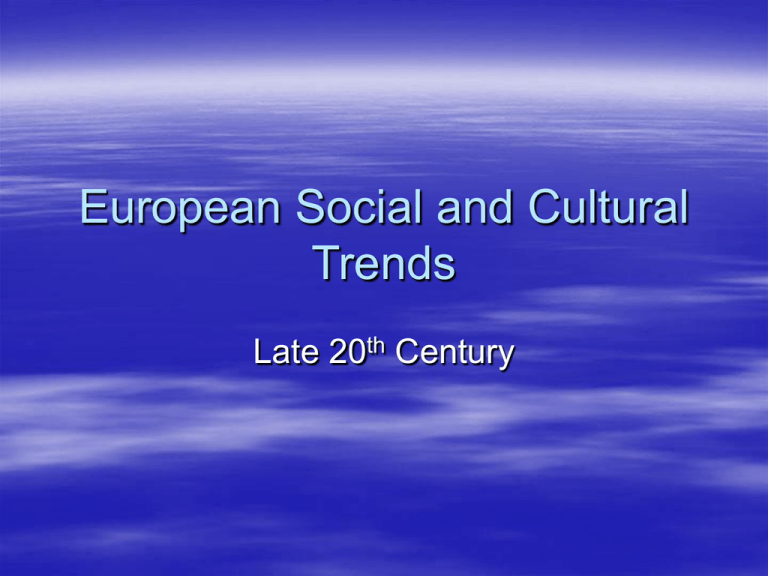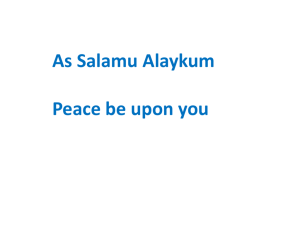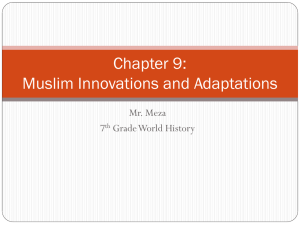European Social and Cultural Trends
advertisement

European Social and Cultural Trends Late 20th Century European Population Trends European birth rates are for the most part dropping Europe has an aging population Migration of 20th Century People Decolonization led people to leave colonies and return to their homeland (e.g. Great Britain received thousands of immigrants from its former colonies in the Caribbean, Africa, and India Racial tensions arrive as many working class people resent the new immigrants Extreme right-wing group National Front in France runs Jean-Marie Le Pen in a losing election to Jacques Chirac in 2002 Similar racist movements arise in many other European countries The New Muslim Population Immigration of Muslims into Europe come from two chief sources – European economic growth – labor shortages lead some European nations to invite “guest workers” to their country – Decolonization – Muslims from India and Salman Rushdie, Muslim IndianAfrica come to Britain, British author of The Satanic while Muslims from Verses Algeria come to France Muslim Culture Muslim immigrants for the most part remain unassimilated and selfcontained, with the women remaining at home European Muslims are not homogeneous coming from different class countries, class backgrounds and different Islamic traditions The presence of foreign-born Muslims whose labor is necessary for the prosperity of the European economy is a major issue in contemporary Europe. Many of these Muslims, such as these women, live in self-contained communities. Christians of the 20th Century and Today Neo-Orthodoxy – presented by Karl Barth, it reemphasized the transcendence of God and the dependence of humankind on the divine Liberal theology – Paul Tillich, Rudolf Bultmann, John Robinson and C.S. Lewis all regarded religion as a human phenomenon, where divinity is sought in human nature and culture Vatican II A Roman Catholic reform movement More liberal ideas in recent times have included; Mass celebrated in the vernacular languages and freer relations with other Christian denominations and Judaism Conservative ideas kept – celibacy of priests, prohibition on abortion and birth control, and no women priests Pope John Paul II emphasized the traditionalist doctrine, firm stands against communism and growth of the church in the non-Western world , while emphasizing social justice •Throughout his pontificate John Paul II continued a close relationship with his native Poland to which he made several visits. •The earliest of these was important in demonstrating the authority of the church against Polish communist authorities. •Shown here in his Polish visit of June 1999, the pope would celebrate mass before several hundred thousand Poles after the collapse of communism which had occurred a decade earlier. Western Culture: Feminism Simone de Beauvoir wrote The Second Sex, exploring the differences being a women made in her life feminist journals published – starting in the 1970’s emphasis in movement in women controlling their own lives New Work Patterns childcare demands decreased by compulsory education and better health care some women financially felt they had to go to work women go to work when their children are old enough to go to school women go back to work after their children have grown women have less children and have children later in life so there is an increase in the work force Women in the New Eastern Europe many of the nations have shown little concern for women’s issues economic difficulties in the region limited the amount health and welfare programs Art Movements: Modernism The term encompasses the activities and output of those who felt the "traditional" forms of art, architecture, literature, religious faith, social organization and daily life were becoming outdated in the new economic, social and political conditions of an emerging fully industrialized world. Modernism rejected the lingering certainty of Enlightenment thinking, and also that of the existence of a compassionate, allpowerful Creator. This is not to say that all modernists or modernist movements rejected either religion or all aspects of Enlightenment thought, rather that modernism can be viewed as a questioning of the axioms of the previous age. The modernist artists we have already studied included the works of post-impressionists, Dadaists, surrealists, etc. Modern Thought From a literary perspective, the main characteristics of modernism include: 1. an emphasis on impressionism and subjectivity in writing (and in visual arts as well); an emphasis on HOW seeing (or reading or perception itself) takes place, rather than on WHAT is perceived. An example of this would be stream-ofconsciousness writing. 2. a movement away from the apparent objectivity provided by omniscient thirdperson narrators, fixed narrative points of view, and clear-cut moral positions. Faulkner's multiply-narrated stories are an example of this aspect of modernism. 3. a blurring of distinctions between genres, so that poetry seems more documentary (as in T.S. Eliot or ee cummings) and prose seems more poetic (as in Woolf or Joyce). 4. an emphasis on fragmented forms, discontinuous narratives, and random-seeming collages of different materials. 5. a tendency toward reflexivity, or self-consciousness, about the production of the work of art, so that each piece calls attention to its own status as a production, as something constructed and consumed in particular ways. 6. a rejection of elaborate formal aesthetics in favor of minimalist designs (as in the poetry of William Carlos Williams) and a rejection, in large part, of formal aesthetic theories, in favor of spontaneity and discovery in creation. 7. A rejection of the distinction between "high" and "low" or popular culture, both in choice of materials used to produce art and in methods of displaying, distributing, and consuming art. T.S. Eliot “The Love Song of J. Alfred Prufrock” Modernist Poet Lived in Europe in the early to mid 1900s http://www.bartleby.co m/198/1.html SNOW cru is ingw Hi sperf ul lydesc E.E. Cummings “Snow” BYS FLUTTERFULLY IF (endbegi ndesignb ecend)tang lesp ang le s ofC omego CRINGE WITHS lilt( -inglyful of)! (s r BIRDS BECAUSE AGAINS emarkable s)h? y&a (from n o(into whe)re f ind) nd ArE GLIB SCARCELYEST AMONGS FLOWERING Existentialism belief that holds human beings totally responsible for their acts and that this responsibility causes dread and anguish Soren Kierkegaard – Danish writer maintained Christianity could be grasped only by lives caught in extreme situations / questioned whether human beings are in control of their own destiny Questioning of Rationalism by Existentialists famous writers; Martin Heidegger, Karl Jaspers, Jean-Paul Sartre, and Albert Camus all questioned the primacy of reason and scientific understanding according to the existentialists, human beings are compelled to formulate their own ethical values and cannot depend on traditional religion, rational philosophy, intuition, or social customs for ethical guidance Jean Paul Sartre and Simone de Beauvoir Post-Modernism Postmodernism is a tendency in contemporary culture characterized by the rejection of objective truth and global cultural narrative. It emphasizes the role of language, power relations, and motivations – in particular it attacks the use of sharp classifications such as male versus female, straight versus gay, white versus black, and imperial versus colonial. – Jaques Derrida and Michael Foucault are classic examples of postmodern philosophers Had its height in the 1960s-1990s Art since World War II Cultural divisions and the Cold War – Tatjiana Yablonskaya –in Bread (1949), showed the realistic propaganda of the Stalinist regime – Jackson Pollack – in One(1950), he showed the exuberance and freedom of abstract “drip” painting More Postmodern Art: Jackson Pollack During the late 1940s and early 1950s Pollock's radical approach to painting revolutionized the potential for all Contemporary art that followed him. To some extent Pollock realized that the journey toward making a work of art was as important as the work of art itself. Pollack’s work No. 5 Pop Art The term "Pop Art" was used to describe paintings that celebrated consumerism of the post World War II era. This movement rejected Abstract expressionism and its focus on the psychological interior, in favor of art which depicted, and often celebrated material consumer culture, advertising, and iconography of the mass production age One way that Pop art is postmodern is that it breaks down what Andreas Huyssen calls the "Great Divide" between high art and popular culture Made famous by Andy Warhol and others Minimalism Rachel Whiteread used the art concept of minimalism (the movement in architecture to remove from an object as many features as possible while retaining the object’s form) in her Nameless Library which commemorates the 65,000 Austrian Jews killed by Nazi Germany Post-Minimalism Performance art that changed with environmental conditions. Brought attention to environmental conditions Americanization of Europe the spread of American influences in the economy, military, and culture to Europe companies such as McDonald’s , Apple. Starbucks, and the Gap have outlets all over Europe music, movies and television shows from the U.S. have also come to Europe has been met by some resentment by people who do not want to lose their European culture Environmentalism concerns about pollution grows in the 1970’s and 1980’s Green Party – an influential political party that started in Germany and were concerned about global warming and pollution Green movement is anticapitalist and anti-nuclear Chernobyl nuclear disaster in Russia in 1986 raised questions about nuclear power that Europe could not ignore In 1989, when a supertanker spilled 35,000 tons of crude oil into Alaska’s Prince William Sound, rescue workers struggled to save the lives of seabirds and animals. Nevertheless, thousands died. Ron Levy/Liaison Agency, Inc. The Computer Age late nineteenth century – the invention of the calculator improves businesses and the cash register appears in the late 1920’s first actual computer – Electronic Numerical Integrator and Computer (ENIAC) – built for ballistics calculations for the U.S. army in 1946 dates – 1960’s – invention of the bitmap to cover the screen, the mouse and the microchip – 1982 – IBM produces small personal computer – 1984 – Apple – produces the Macintosh – computer for a desktop at home or office and set for commercial sales becomes available – mid-1980’s – computer sales boom – mid 1990’s - present – the internet boom The earliest computers were very large. Here in a 1946 photograph J. Presper Eckert and J. W. Mauchly stand by the Electronic Numerical Integrator and Computer (ENIAC) which was dedicated at the University of Pennsylvania Moore School of Electrical Engineering. CORBIS/Bettmann “Modern” Art Art in the current day tends to use common objects in new ways and to use computers to synthesize new ways of looking at things More “Modern” Art Photorealism Realism has made a resurgence as well with Photorealism Yes, this is an oil painting not a photograph






